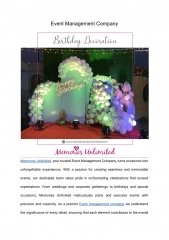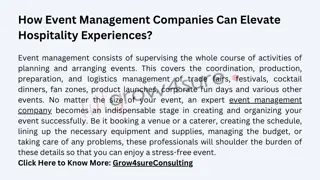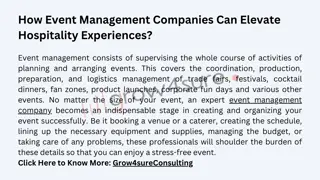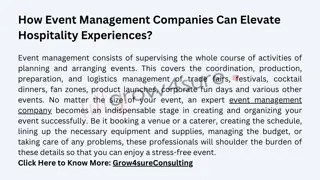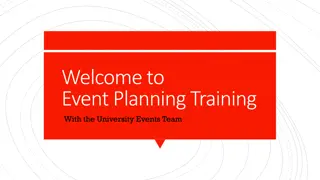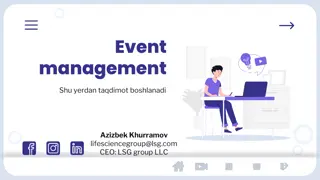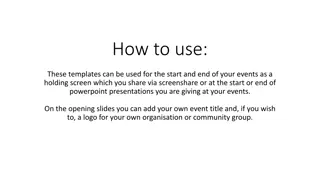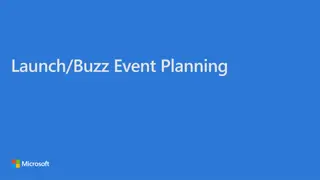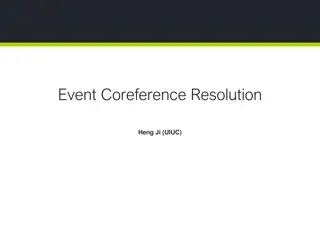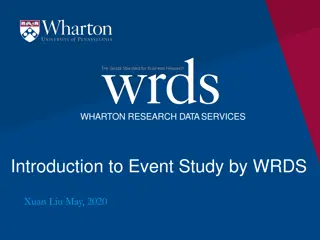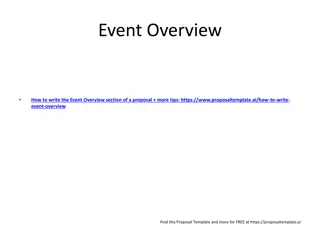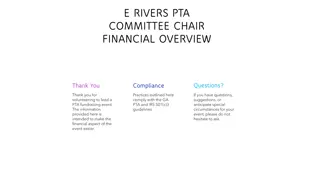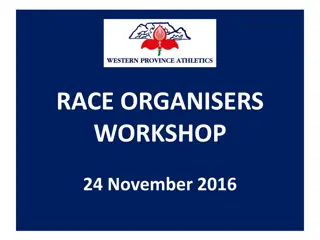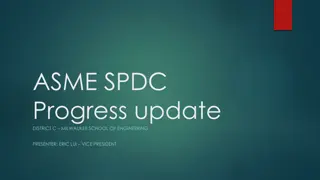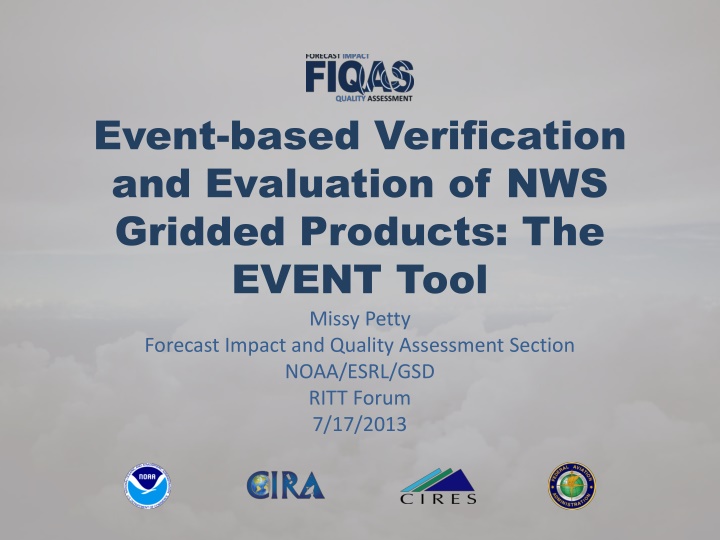
Event-Based Verification and Evaluation of NWS Gridded Products
Enhance the understanding of weather information through impact-based assessments for effective decision-making in high-impact weather events. The EVENT tool and FIQAS section focus on independent quality assessments of aviation weather forecast products. The development of the EVENT Background Tool supports NWS efforts in measuring forecast accuracy related to aviation traffic flow management decisions. TRWG Requirements DRAFT Table N-4 outlines forecast performance values for traffic flow management in near- and mid-term weather support. Dive into these assessment sections to advance weather information usage and decision support technologies.
Download Presentation

Please find below an Image/Link to download the presentation.
The content on the website is provided AS IS for your information and personal use only. It may not be sold, licensed, or shared on other websites without obtaining consent from the author. If you encounter any issues during the download, it is possible that the publisher has removed the file from their server.
You are allowed to download the files provided on this website for personal or commercial use, subject to the condition that they are used lawfully. All files are the property of their respective owners.
The content on the website is provided AS IS for your information and personal use only. It may not be sold, licensed, or shared on other websites without obtaining consent from the author.
E N D
Presentation Transcript
Event-based Verification and Evaluation of NWS Gridded Products: The EVENT Tool Missy Petty Forecast Impact and Quality Assessment Section NOAA/ESRL/GSD RITT Forum 7/17/2013
FIQAS Forecast Impact and Quality Assessment Section Mission: Advance the understanding and use of weather information through impact-based assessments and targeted information delivery to benefit decision making in response to high-impact weather events Primary activities Independent assessments of quality and skill of aviation weather forecast products in or transitioning to NWS or FAA operations Development of technologies to present and/or disseminate quality and skill information for analysis and decision support Forecast Impact and Quality Assessment Section 2
EVENT Background Tool development sponsored by NWS Supports NWS efforts to measure forecast accuracy relative to aviation traffic flow management decisions Skill information is framed by requirements established by the Traffic Flow Management Weather Requirements Working Group (TRWG) Forecast Impact and Quality Assessment Section 3
TRWG Requirements DRAFT Table N-4. Forecast Performance Values for Traffic Flow Management for Near- and Mid-Term Weather Support DRAFT Accuracy Timing Error Probability of Detection Lead Time False Alarm Rate Location Error (minutes) (minutes) Near Term MOC Near Term MOC Near Term MOC Near Term MOC Near Term MOC 0 - 2 h 15 min 10 min 80% 85% 20% 15% 15 min 10 min 3 nm 3 nm > 2 - 4 h 30 min 20 min 75% 80% 25% 20% 30 min 20 min 3 nm 3 nm Time of Onset > 4 - 6 h 45 min 30 min 70% 75% 35% 25% 45 min 30 min 3 nm 3 nm > 6 - 8 h 60 min 45 min 65% 75% 40% 30% 60 min 45 min 3 nm 3 nm > 8 - 18 h 60 min 70% 35% 60 min 3 nm Thunderstorms for Core Airports with: > 18 - 36 h 75 min 65% 40% 75 min 3 nm Probability 50% > 36 - 48 h 90 min 60% 45% 90 min 3 nm Area Diameter 150 nm 0 - 2 h 15 min 10 min 80% 85% 20% 15% 15 min 10 min 3 nm 3 nm > 2 - 4 h 30 min 20 min 75% 80% 25% 20% 30 min 20 min 3 nm 3 nm > 4 - 6 h 45 min 30 min 70% 75% 35% 25% 45 min 30 min 3 nm 3 nm Time of Cessation > 6 - 8 h 60 min 45 min 65% 75% 40% 30% 60 min 45 min 3 nm 3 nm > 8 - 18 h 60 min 70% 35% 60 min 3 nm > 18 - 36 h 75 min 65% 40% 75 min 3 nm > 36 - 48 h 90 min 60% 45% 90 min 3 nm Forecast Impact and Quality Assessment Section 4
EVENT Techniques Event-based techniques developed as part of an assessment of NDFD as compared to other operational forecasts Evaluation of forecast performance in prediction of thunderstorms Terminal and en-route contexts Terminal: Do forecasts accurately predict significant thunderstorms within a 75 nmi radius of the terminal? En-route: Do forecasts accurately predict significant high- altitude thunderstorm activity that affects en-route flow along jetways in the northeast? Determine by lead time the temporal and spatial displacement error for event onset and cessation Forecast Impact and Quality Assessment Section 5
EVENT-based Techniques: Challenges Comparison of different forecasts ( apples-to- apples ) Definition of an event Determining a forecast-observation event match Computing appropriate skill scores Forecast Impact and Quality Assessment Section 6
Forecasts Product Fields/Thresholds NDFD (5km) Treated probabilistically, using Trace and Likely thresholds Convective Precip >= 1mm RAP (hourly, 13.5km) LAMP (hourly, 2.5km) Thunderstorm probability Forecast Impact and Quality Assessment Section 7
Observations Definition of a thunderstorm Moist convection + lightning Thunderstorm observation produced by Combining CIWS VIL (15 min, 1km) with National Lightning Data Network (NLDN) data *Note: Total lightning used to determine the CIWS VIL and NLDN strike characteristics needed to identify the presence of a thunderstorm 8
Instantaneous Events: Terminal The domain of interest is 75-nmi radius around each of the core-30 airports Approach applies to both forecasts and observations The coverage of the forecast within terminal domain is computed Coverage weighted by probability for probabilistic forecasts If coverage exceeds 10%, an instantaneous thunderstorm event is identified 9
Instantaneous Events: Jetway (En-route context) High-traffic jetways intersecting/bounded by NE Flow Constrained Area boundaries (AFP 05 and 08) Three Jetway Regions All, East-West, North-South Combination of jet routes Jetway is buffered by 20nmi and partitioned into 40nmi segments If segment along a jetway is blocked with a Flow Constraint Index (FCI) > 0.5, then the jetway is blocked An instantaneous event occurs if 10% of all jetways within a region are blocked 10
Merging Events Instantaneous events are merged, for both forecasts and observations, into events with duration Merging occurs per forecast lead NDFD Centric merging criteria was applied: Instantaneous events are merged into a larger event if time between events is less than 3 hours If NDFD is excluded, 1 hour merging criteria is applicable Forecast Impact and Quality Assessment Section 11
Matching of Merged Events Onset and cessation are treated separately Matches are computed per forecast lead Temporal criteria for a match is applied using a 3 hour window Pairings are optimized according to the Gale-Shapley (1962) procedure Hit Miss Miss Miss Miss Hit Hit Hit Obs Forecast False Alarm Hit False Alarm Hit Hit Hit 12
Temporal Displacement Displacement can be calculated only for matched onsets and cessations Tonset = Fonset Oonset Tcessation = Fcessation Ocessation Oonset Obs Fonset Forecast Tonset 13
Spatial Displacement For all matched onset and cessation pairs Center of mass is weighted by forecast probability The average of the minimum distances between all forecast objects and observation objects yields the spatial displacement Y X X X X X Forecast CIWS observation X = Center of mass (CM) Distance between CMs 14
Metrics For onset and cessation, the following statistics are computed: POD (Probability of Detection) Percentage of all observed events that are correctly forecast FAR (False Alarm Ratio) Percentage of all forecasts that are incorrect CR (Correspondence Ratio= ratio of intersection to union) A measure of agreement of forecasts and observations Displacement Spatial Temporal Forecast Impact and Quality Assessment Section 15
EVENT Architecture FIQAS Data Servers FIQAS Web-servers F I R E W A L L Data Data Storage - MYSQL Database User Interface - Apache Django Python Data Storage - MYSQL Database Acquisition And Processing - Python Java Internet Replication Forecast Impact and Quality Assessment Section 16
EVENT DEMO EVENT DEMO Forecast Impact and Quality Assessment Section 17
Future Work Incorporate HRRR into tool Incorporate MRMS as a replacement for CIWS Enhance en-route techniques (FCI) Develop Event viewer to view accuracy for specific events Forecast Impact and Quality Assessment Section 18
QUESTIONS? QUESTIONS? Forecast Impact and Quality Assessment Section 19
More Information Contact: Missy Petty, melissa.a.petty@noaa.gov EVENT URL: http://esrl.noaa.gov/fiqas/tech/event/ Forecast Impact and Quality Assessment Section 20

